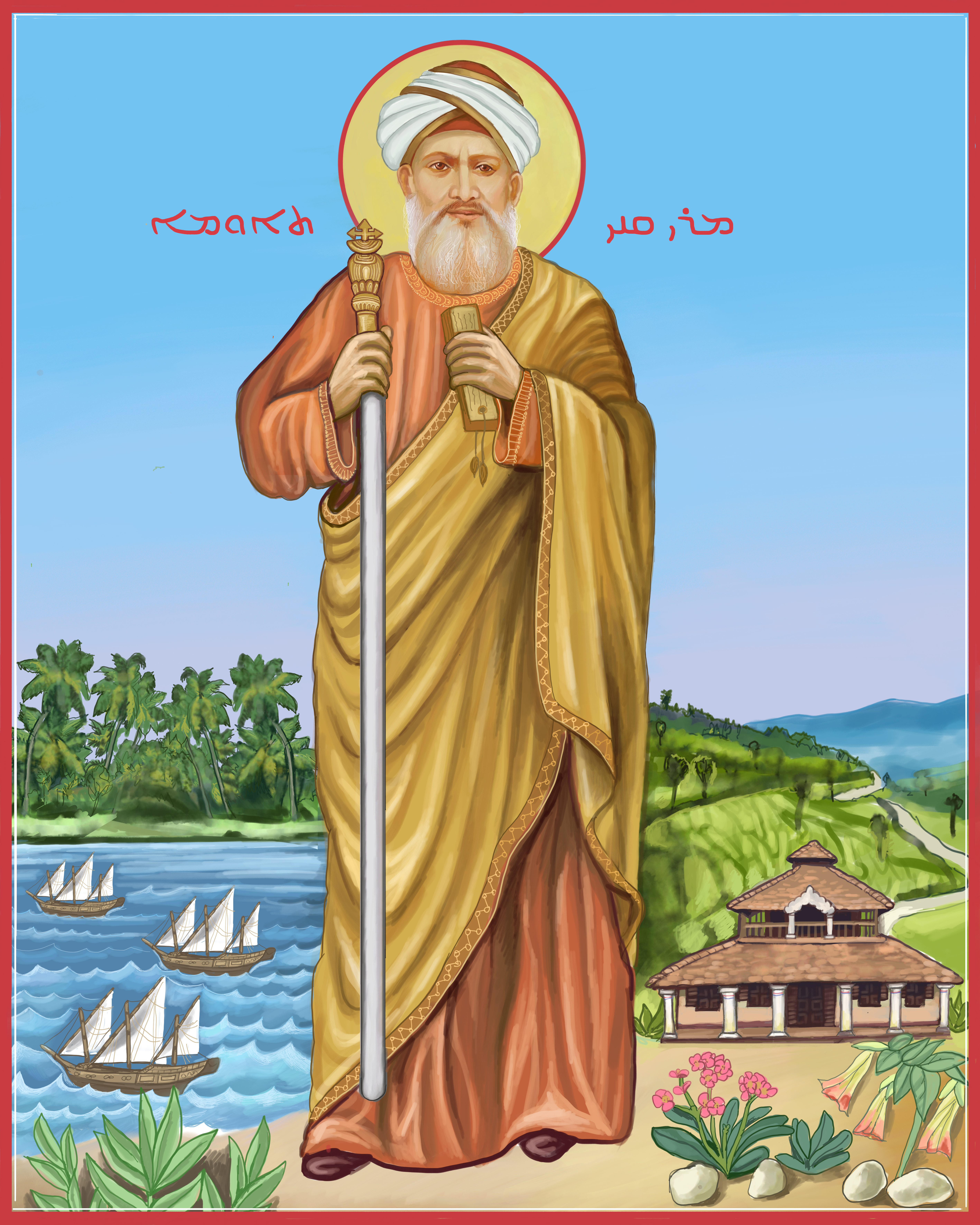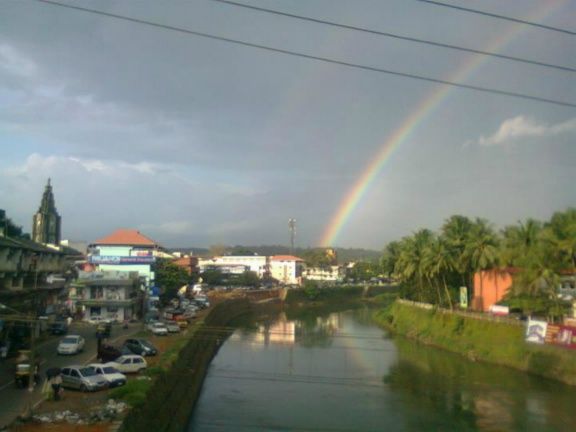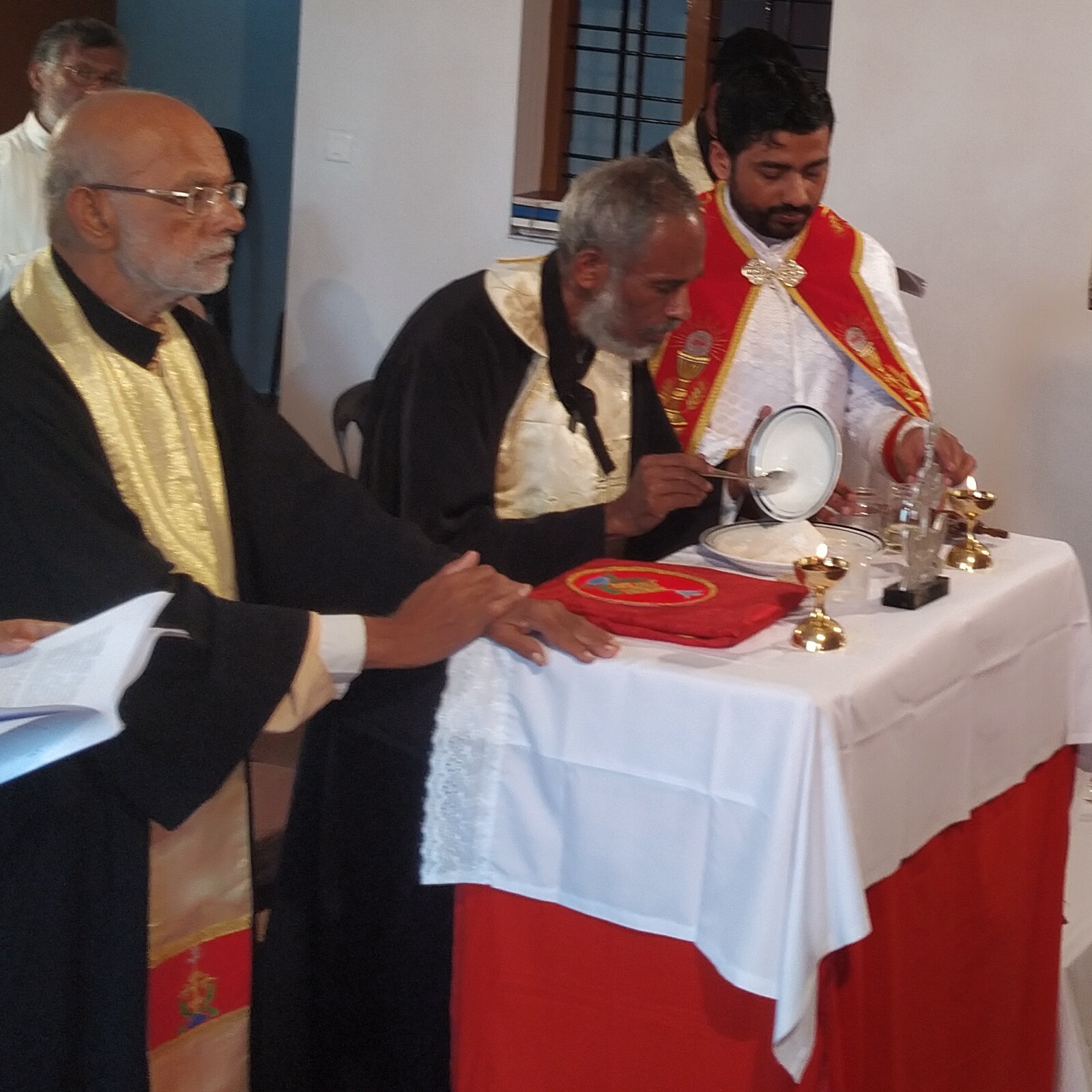|
Cherpunkal
Cherpunkal is a small town in the Kottayam district of Kerala State in India on the Kottayam-Palai Road, seven kilometers from Palai city. Cherpunkal is famous for Mar Sleeva Forane Catholic Church, believed to have been established by Thomas the Apostle. It is also believed that St.Thomas left his sandals there while taking a bath in a nearby Meenachil River. Mar Sleeva Forane Church, Cherpunkal On the southern banks of the Meenachil River is the Holy Cross Forane Church of Cherpunkal is situated. Mar Sleeva is a Syriac word which means the Holy Cross. The church belongs to the Syro Malabar Catholic Church and under the diocese of Palai. The church premises sprawl along the river side and include the old and new churches, the presbytery, the old and new parish halls and the swanky buildings housing the High School, the Higher Secondary School and the Bishop Vayalil Memorial Holy Cross College with the terraced church cemetery in the background right across the Kezhuvamku ... [...More Info...] [...Related Items...] OR: [Wikipedia] [Google] [Baidu] |
Kottayam District
Kottayam (), is one of 14 districts in the Indian state of Kerala. Kottayam district comprises six municipal towns: Kottayam, Changanassery, Pala, Erattupetta, Ettumanoor, and Vaikom. It is the only district in Kerala that neither borders the Arabian Sea nor any other states. The district is bordered by hills in the east, and the Vembanad Lake and paddy fields of Kuttanad on the west. The area's geographic features include paddy fields, highlands, and hills. As of the 2011 census, 28.6% of the district's residents live in urban areas, and it reports a 97.2% literacy rate. In 2008, the district became the first tobacco-free district in India. Kottayam registered the lowest Multidimensional Poverty Index (MPI) of zero among all districts of India, indicating no deprivation as per the report published by Oxford Poverty and Human Development Initiative and UNDP for districts across India. The district's headquarters are based in the city of Kottayam. Hindustan Newsprint Limited ... [...More Info...] [...Related Items...] OR: [Wikipedia] [Google] [Baidu] |
Knanaya
The Knānāya, (from Syriac: ''Knā'nāya'' (Canaanite)) also known as the Southists or Tekkumbhagar, are an endogamous ethnic group found among the Saint Thomas Christian community of Kerala, India. They are differentiated from another part of the community, known in this context as the Northists (''Vaddakkumbhagar''). There are about 300,000 Knanaya in India and elsewhere. The origins of the Knanaya community is traced back to the arrival of the Syriac merchant Thomas of Cana (Knāi Thoma) who led a migration of Syriac Christians ( Jewish-Christians) from the Mesopotamian province of Sassanian Persia to India in the fourth or eighth century. The communities arrival was recorded on the Thomas of Cana copper plates which were extant in Kerala until the 17th century. The ethnic division between the Knanaya and other St. Thomas Christians was observed during the Portuguese colonization of India in the 16th century and was noted throughout the European colonial era. Today, the majo ... [...More Info...] [...Related Items...] OR: [Wikipedia] [Google] [Baidu] |
Meenachil River
The Meenachil River or Meenachilaar (Malayalam: ), also known as Kavanar, Valanjar, is a river in Kerala. It is one of the most treacherous rivers in Kerala due to its flash floods, heavy undercurrents and woods and debris it carries from the mountains. It flows through the heart of Kottayam district, Kerala state in southern India. 78km long, originates in the Western Ghats main tributaries are Theekoy aaru from Vagamon hills, Poonjar Aaru and Chittar, flowing westward through the city of Kottayam and other towns like Poonjar, Teekoy, Erattupetta, Bharananganam, Pala, Mutholy, Cherpunkal, Kidangoor and Kumarakom before emptying into the Vembanad Lake on the shore of the Indian Ocean. General elevation ranges from 77 m to 1156 m in the highlands and less than 2 m in the lowlands and 8 to 68 m in the midlands. The Meenachil has a watershed area of 1208.11 km². The river has a total annual yield of 2,349 million cubic metre and an annual utilizable yield of 1110 ... [...More Info...] [...Related Items...] OR: [Wikipedia] [Google] [Baidu] |
States And Union Territories Of India
India is a federal union comprising 28 states and 8 union territories, with a total of 36 entities. The states and union territories are further subdivided into districts and smaller administrative divisions. History Pre-independence The Indian subcontinent has been ruled by many different ethnic groups throughout its history, each instituting their own policies of administrative division in the region. The British Raj mostly retained the administrative structure of the preceding Mughal Empire. India was divided into provinces (also called Presidencies), directly governed by the British, and princely states, which were nominally controlled by a local prince or raja loyal to the British Empire, which held ''de facto'' sovereignty ( suzerainty) over the princely states. 1947–1950 Between 1947 and 1950 the territories of the princely states were politically integrated into the Indian union. Most were merged into existing provinces; others were organised into ... [...More Info...] [...Related Items...] OR: [Wikipedia] [Google] [Baidu] |
Syro Malabar Catholic Church
lat, Ecclesia Syrorum-Malabarensium mal, മലബാറിലെ സുറിയാനി സഭ , native_name_lang=, image = St. Thomas' Cross (Chennai, St. Thomas Mount).jpg , caption = The Mar Thoma Nasrani Sliva or Saint Thomas christian cross, the symbol of the Syro-Malabar Church. , abbreviation=SMC, type = Catholic particular churches and liturgical rites, Self-governing church (''sui iuris'') , main_classification = Eastern Catholic , orientation = Eastern Christianity(Syriac Christianity) , scripture = , polity = Episcopal polity , governance=Holy Episcopal Synod of the Syro-Malabar Church, theology = East Syriac theology , leader_title = Pope , leader_name = Pope Francis, Francis , leader_title1 = Major Archbishop , leader_name1 = George Alencherry , leader_title3 = Administration , leader_name3 = Major Archiepiscopal Curia , ... [...More Info...] [...Related Items...] OR: [Wikipedia] [Google] [Baidu] |
Our Lady Of Sorrows
Our Lady of Sorrows ( la, Beata Maria Virgo Perdolens), Our Lady of Dolours, the Sorrowful Mother or Mother of Sorrows ( la, Mater Dolorosa, link=no), and Our Lady of Piety, Our Lady of the Seven Sorrows or Our Lady of the Seven Dolours are names by which Mary, mother of Jesus, is referred to in relation to sorrows in life. As ', it is also a key subject for Marian art in the Catholic Church. The Seven Sorrows of Mary are a popular religious theme and a Catholic devotion. In Christian imagery, the Virgin Mary is portrayed sorrowful and in tears, with one or seven swords piercing her heart, iconography based on the prophecy of Simeon in Luke 2:34–35. Pious practices in reference to this title include the Chaplet of the Seven Sorrows, the Seven Principal Dolors of the Blessed Virgin, the Novena in Honor of the Seven Sorrows of Mary, and the ''Via Matris''. The feast of Our Lady of Sorrows is liturgically celebrated every 15 September, while a feast, the Friday of Sorrows is obs ... [...More Info...] [...Related Items...] OR: [Wikipedia] [Google] [Baidu] |
Mahatma Gandhi University, Kerala
Mahatma Gandhi University (MGU), commonly referred to as MG University, is a state owned public university headquartered in Kottayam in the state of Kerala, India. It was established on 2 October 1983 on Gandhi Jayanti day. Mahatma Gandhi University (formerly Gandhiji University) has been approved by University Grants Commission (UGC) and accredited (A) by the National Assessment and Accreditation Council of India. The university has around 300 affiliated colleges spread over five districts in central Kerala. Academics The university offers around 300 academic programmers (Bachelor's, Master's, Doctoral degrees) in the fields of Pure and Applied Sciences, Technology, Paramedical Studies, Nursing, Management, Law, Engineering, Gandhian Thought, development studies, International Relations, Inter disciplinary Integrated Master of Sciences, Politics, Physics, Nano Science, Disability Studies, Rehabilitation Sciences, Special Education, Psychology, Behavioral Medicine, Tourism, ... [...More Info...] [...Related Items...] OR: [Wikipedia] [Google] [Baidu] |
Infant Jesus
The Christ Child, also known as Divine Infant, Baby Jesus, Infant Jesus, the Divine Child, Child Jesus, the Holy Child, Santo Niño, and to some as Señor Noemi refers to Jesus Christ from his nativity to age 12. The four canonical gospels, accepted by most Christians today, lack any narration of the years between Jesus' infancy and the Finding in the Temple when he was 12. Liturgical feasts Liturgical feasts relating to Christ's infancy and childhood include: * The Feast of the Nativity of Jesus Christ (25 December); * The Feast of the Circumcision of Christ (1 January – Eastern Orthodox Church, Latin Rite-Extraordinary Form); * The Feast of the Holy Name of Jesus (3 January – Latin Rite; others – various); * The Feast of the Epiphany (6 January or 19 January in the Gregorian equivalent of the Julian calendar) * The Feast of the Presentation of the Lord (2 February) Depictions in art From about the third or fourth century onwards, the child Jesus is frequently shown ... [...More Info...] [...Related Items...] OR: [Wikipedia] [Google] [Baidu] |
Circumcision Of Jesus
The circumcision of Jesus is an event from the life of Jesus, according to the Gospel of Luke chapter 2, which states: And when eight days were fulfilled to circumcise the child, his name was called Jesus, the name called by the angel before he was conceived in the womb. The eight days after his birth is traditionally observed January 1. This is in keeping with the Jewish law which holds that males should be circumcised eight days after birth during a Brit milah ceremony, at which they are also given their name. The circumcision of Christ became a very common subject in Christian art from the 10th century onwards, one of numerous events in the ''Life of Christ'' to be frequently depicted by artists. It was initially seen only as a scene in larger cycles, but by the Renaissance might be treated as an individual subject for a painting, or form the main subject in an altarpiece. The event is celebrated as the Feast of the Circumcision in the Eastern Orthodox Church on January 1 ... [...More Info...] [...Related Items...] OR: [Wikipedia] [Google] [Baidu] |
Gothic Architecture
Gothic architecture (or pointed architecture) is an architectural style that was prevalent in Europe from the late 12th to the 16th century, during the High and Late Middle Ages, surviving into the 17th and 18th centuries in some areas. It evolved from Romanesque architecture and was succeeded by Renaissance architecture. It originated in the Île-de-France and Picardy regions of northern France. The style at the time was sometimes known as ''opus Francigenum'' (lit. French work); the term ''Gothic'' was first applied contemptuously during the later Renaissance, by those ambitious to revive the architecture of classical antiquity. The defining design element of Gothic architecture is the pointed or ogival arch. The use of the pointed arch in turn led to the development of the pointed rib vault and flying buttresses, combined with elaborate tracery and stained glass windows. At the Abbey of Saint-Denis, near Paris, the choir was reconstructed between 1140 and 1144, draw ... [...More Info...] [...Related Items...] OR: [Wikipedia] [Google] [Baidu] |
Thomas Kurialacherry
Venerable Thomas of Kurialacherry (14 January 1873 – 2 June 1925) was a Catholic bishop from Kerala. Kurialacherry was a member of the Syro-Malabar Catholic Church, and was the first bishop of what would become the Archdiocese of Changanassery. Life Kurialacherry was born on 14 January 1873 as the sixth child of Chackochen and Accamma in Champakulam, Kerala. He was baptized on the eighth day and was christened Thomas. After his primary education, Thomas joined St.Ephrem school in Mannanam.It was during this time that he felt a strong desire to become a priest. His seminary education was at the seminary of the Propaganda Fide in Rome. During the nine years he spent in Rome he excelled and became prefect of the seminarians. He was ordained on 27 March 1899 by Cardinal Cassantha at the Basilica of St. John in Lateran. After his ordination, he remained some time in Italy visiting various shrines. It was then that he was a guest for some days of Giuseppe Cardinal Sarto, Pat ... [...More Info...] [...Related Items...] OR: [Wikipedia] [Google] [Baidu] |

.jpg)



.jpg)

.jpg)